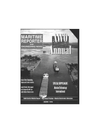
Page 17: of Maritime Reporter Magazine (March 1996)
Read this page in Pdf, Flash or Html5 edition of March 1996 Maritime Reporter Magazine
Sweden upgrades with special task craft
A completely new type of special task vessel has been delivered to the Swedish Navy for use by the amphibious battalions. Forming the first step in the current upgrading of Sweden's naval resources, the 39.4-ft. (12-m) long
SRC 90E is likely to prove itself among the most versatile in the small craft fleet, reportedly able to move through very shallow waters with outstanding maneuverability.
Sea trials confirmed that the builder, Storebro Royal Cruiser, had succeeded in meeting the pro- ject goal — to create a boat with an extremely tight turning circle and very short stopping distances which handled well, even at very high speeds.
The vessels are small but reput- ed to be extremely rugged, with hull and superstructure made from a carbon fiber-reinforced vinylester sandwich. The keel and hull bot- tom are reinforced with built-in laminate rubbing protection to enable safe beaching when landing troops. Comfort for the crew has been achieved by placing the wheelhouse and passenger mod- ules in an elastic suspension sys- tem and by the generous use of sound insulation material.
The SRC 90 E is powered by a
Scania DSI 14 diesel engine, which develops 625 bhp, coupled to an FF jet 410 hydro jet unit. This propul- sion package was developed in col- laboration with the Swedish
Defence Material Administration and reportedly powers the vessel to speeds in excess of 40 knots.
The boat type was specified and designed by Petter Hakansson, head of the Ships Directorate at
The first of a new generation
MAN B&W Diesel A/S =~== 0stervej 2, DK-4960 Holeby. Telephone: +45 54 69 31 00 GENERATING SETS
Circle 219 on Reader Service Card
MAN B&W Holeby announces the L16/24 GenSet, a family of engines that delivers 500-900 kW at 1,200 rpm they are the first of a new generation.
Your first look will tell you that it is a very special
GenSet. You will be surprised by its clean, stream- lined exterior, uncluttered by tubes and pipes. You will be even more surprised when you discover the many technical innovations we have built in to make it the most cost-effective GenSet in its class.
State-of-the-art computer-aided engineering has been used to create a compact, easily maintained engine which uses the same inexpensive heavy fuel oil as the vessel's propulsion engines. With optimal efficiency across the entire power spectrum, from idle to full load, including the start/stop phase.
MAN B&W Holeby has been producing fine diesel engines since 1910. Engines renowned for their reliability, operating economy and ease of maintenance.
That is why we can say with confidence that the
L16/24 sets the standard for the auxiliary diesel engines that will provide power for the world's merchant fleet long into the 21st century.
L16/24
MacGregor Clinches RoRo
Door Deal (Continued from previous page)
The top-stowing design operates in a similar manner, except the tracks run ver- tically at the ship's sides or casings.
When unloading, the crew opens all doors before passengers are allowed access to the car deck.
The jalousie concept — good for both newbuilds and retrofits — minimizes the loss of cargo space and reduces distur- bance to traffic flow during loading and unloading of the car deck. Other fea- tures include minimal reductions to free heights and lane widths, and a door structure which can accommodate de- flections of the hull and decks. Although now reaping the benefits of substantial contracts, MacGregor should be credited for giving time, effort and money to the research and investigation processes conducted by maritime authorities in
Scandinavian countries in the develop- ment of new rules. MacGregor partici- pated in the committee which worked out rule proposals for "bow doors and their closing and securing," and assisted the
Accident Investigation Commission by carrying out investigations and calcula- tions following the Estonia accident.
Furthermore, together with Silja Line and
Kvaerner Masa-Yard, the company has financed and supported a study of bow door wave pressure impacts carried out by the Technical Research Centre of
Finland. In this study, full scale measure- ments were made on the ferry Silja
Symphony. Results were analyzed, and the need for bow door requirements, as expressed in the "Nordic rule proposal," was confirmed.
MacGregor fitted a telescopic type flood control door on Silja Symphony in 1994. In addition to this, inner bow doors have been delivered and bow reinforcements completed on approxi- mately 35 European RoRo ferries.
For more information from MacGregor
Circle 91 on Reader Service Card
March, 1996 79

 16
16

 18
18
